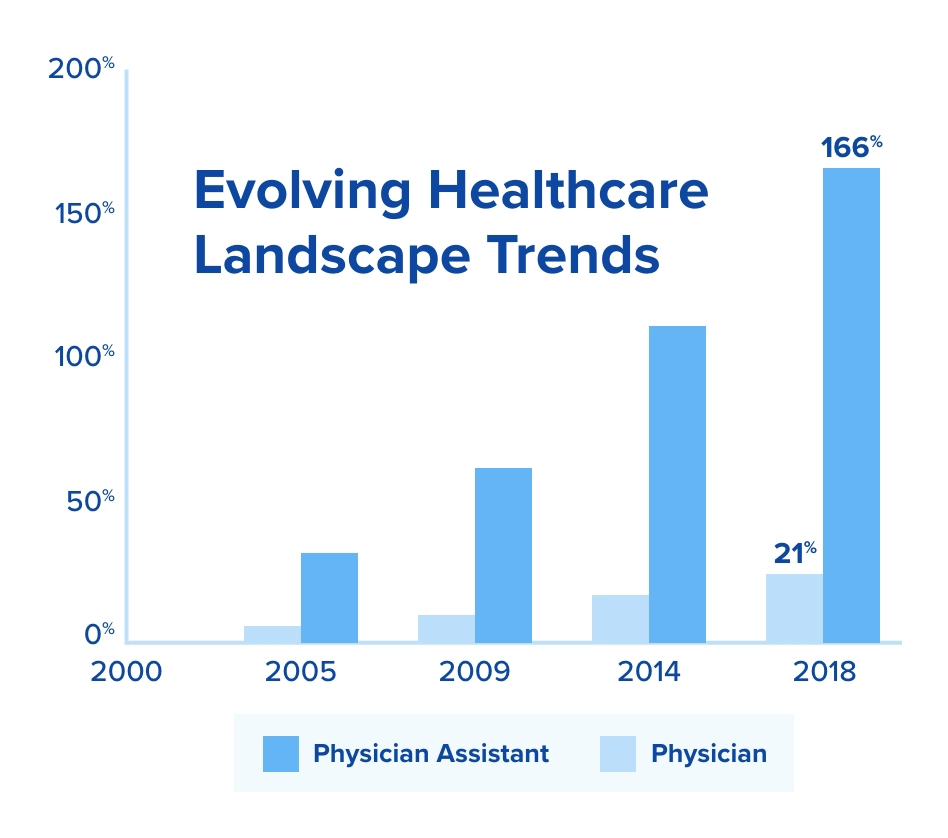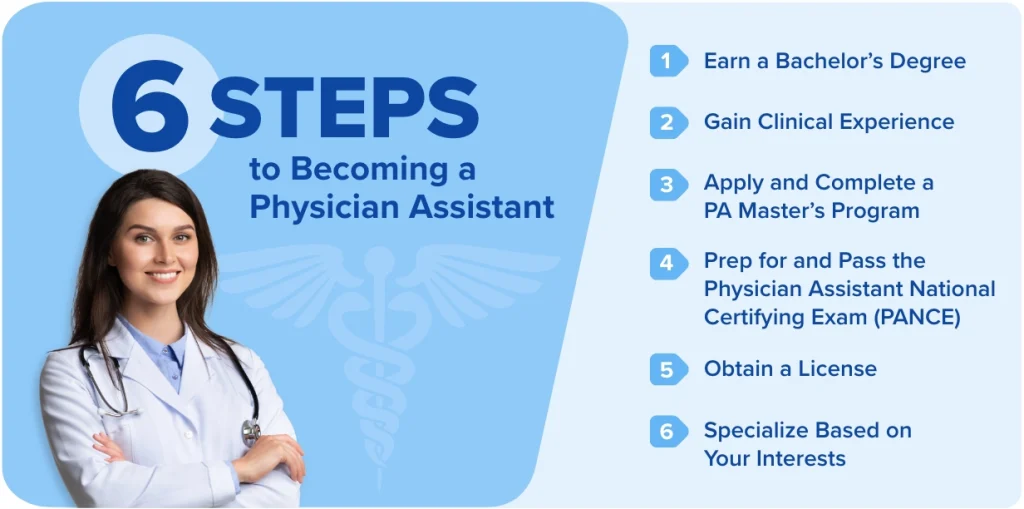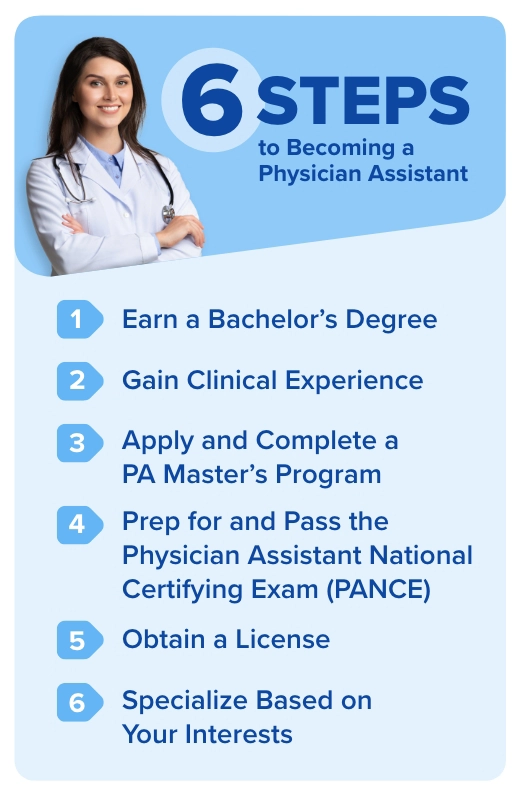The Ultimate Guide to Exploring Enriching Physician Assistant Specialties
Explore the diverse landscape of PA specialties and learn more about the unique roles and specialized areas PAs can pursue to make a significant impact in healthcare.
Start your FREE PA QBank trial to kickstart your journey and experience case-based questions across a variety of specialties.

Discover the benefits of specializing as a PA, the top highest-paying fields, and a roadmap you can follow to obtain licensure. Gain insight into niche areas to figure out how to choose the perfect PA career that aligns with your interests.
Career Outlook for Physician Assistants
Physician Assistants are highly-trained healthcare professionals who offer a wide range of services. PAs are instrumental in providing generalized and nuanced patient care. As a PA, your day-to-day involves working with patients to make a significant impact. It's a rewarding, thriving career field.
In fact, the rising aging population and an enhanced focus on preventive care have built a growing demand for PAs. The Bureau of Labor Statistics projects a 27% increase in Physician Assistant jobs (from 2022 to 2032).

PA salaries have also increased by 14% in the last five years. Additionally, the PA profession is expanding due to:
- The evolving needs of patient care
- Filling access gaps
- The Affordable Care Act (by improving healthcare quality and resources)
What is the benefit of pursuing a physician assistant specialty?
Following a specialized path to a Physician Assistant career is a profoundly rewarding and professionally enriching journey. Gaining experience in a targeted PA specialty makes you an indispensable expert in a healthcare field aligned with your passions and interests. You'll find open doors to a spectrum of possibilities, including enhanced job satisfaction, competitive remuneration, and a profound sense of fulfillment from impacting patients' lives.
Embrace your dream career where professionalism meets purpose, and every day presents a new opportunity. Let's dive into some additional benefits of Physician Assistant specialties.
| Expertise in a Specific Area: | Specializing allows you to focus on a particular medical field, gaining in-depth knowledge and expertise. This can lead to a deeper understanding of conditions, treatments, and procedures. |
| Increased Job Opportunities: | Training often creates access to more job opportunities. Certain healthcare settings may prefer or require PAs with specialized skills to address niche patient needs. |
| Higher Earning Potential: | Specialized areas of the Physician Assistant profession tend to earn higher salaries than generalists. The expertise and additional training can be recognized and rewarded in compensation. |
| Career Satisfaction: | Working as a PA can provide you with a sense of fulfillment and satisfaction. PAs may find greater enjoyment and purpose in their work when focused on a particular area of medicine. |
| Patient Care Impact: | PAs impact patient care significantly within a specific niche. They can become experts in diagnosing and treating conditions within their chosen field, improving patient outcomes. |
| Professional Development: | Staying updated on the latest advancements in the chosen field can contribute to your professional growth and development. |
| Networking Opportunities: | PAs often have the chance to build relationships with other professionals in their niche. Networking can lead to collaboration, knowledge sharing, and career advancement opportunities. |
| Contributions to Research and Education: | PAs can contribute to research, educate others in their field, and participate in advancements that can benefit patients and the medical community. |
How to Choose the Right Physician Assistant Specialty
Finding the right PA career is an important decision that depends on various factors, including personal interests, values, and skills. Take a look at some steps to help you decide how your professional preferences will align with different Physician Assistant specialties:
- Complete a self-assessment: Reflect on your personal interests and skills to identify areas of medicine that will interest you.
- Research PA specialties: There are more than 60 specialties to choose from, including anesthesia, cardiology, dermatology, hospital medicine, pediatrics, and surgery. Research each specialty to understand the responsibilities, work environment, and job outlook.
- Gain clinical experience: During your PA program, you'll complete clinical training in various areas, which can help you determine which specialties align with your interests and skills.
- Consider salary and job growth: While salary should not be the sole factor, it's essential to consider the earning potential and job growth for each PA field.
- Be open to change: Your first PA job does not have to be your last. As you gain experience, you should explore other areas of interest.
Looking to try exam-like practice questions across PA specialties? The UWorld PA QBank includes all PA topics covered in EORs, PANCE, and PANRE.

Can PAs change specialties?
You can change specialties throughout your career as a Physician Assistant (PA). You may need additional training and certifications, but you'll have the flexibility to pursue new areas of focus based on your preferences. Consider a scenario where a PA specializing in Emergency Medicine decides to transition to Dermatology. This might involve:
- Postgraduate Dermatology Fellowship
- Continuing Medical Education (CME) Courses
- Board Certification in Dermatology
- Clinical Experience
Your Path to Physician Assistant Specialties: Training and Education
To specialize as a Physician Assistant (PA), follow these steps:
- Earn a Bachelor's Degree: Take relevant undergraduate courses in preparation for a PA Master’s program.
- Acquire Clinical Experience: Gain experience in various healthcare settings to become familiar with the day-to-day responsibilities of a physician assistant.
- Apply for and Complete Graduate School: Submit your graduate school application. Then, continue your education to complete a Master's program.
- Prep for the PANCE: Study comprehensive PA content to prepare for your high-stakes exam.
- Obtain Your Licensure: After passing the PANCE, become a PA-C (Physician Assistant-Certified).
- Find Your Specialty by Pursuing Fellowship Opportunities: Look for positions or programs based on your interests. Consider fellowship programs such as:
- Surgical PA Fellowship
- Primary Care Fellowship
- Pediatric PA Fellowship


Helpful examples of fellowship opportunities for various PA specialties
Thankfully, several fellowship opportunities are available for aspiring Physician Assistants like you. Fellowships typically last 12 to 18 months and provide intense, organized training for PAs. Some of the popular PA fellowship programs include:
- Emergency Medicine PA Fellowship: This 18-month on-the-job training program includes rotations in the ED, SICU, MICU, Hospital Medicine, Toxicology, EMS, Anesthesia, Orthopedics, and a Pediatric ED.
- Centra Health PA Fellowships: Centra Health offers various 9-month fellowships designed for new graduate PAs, including didactic instruction and hands-on clinical training.
- Brigham and Women's Physician Assistant Fellowship: To make strides toward decreasing the gender pay gap, Brigham provides a 12-month postgraduate inpatient fellowship program with competitive compensation and full benefits.
Navigate the PA Workforce by Specialty
The PA profession is jam-packed with diverse positions, fields, and opportunities. Let's dive into a breakdown of each PA specialty by percentage.
| Primary Care | 23.1% |
| Family Medicine/General Practice | 17.1% |
| Emergency Medicine | 11.2% |
| Orthopedic Surgery | 10.7% |
| Dermatology | 4.2% |
| Internal Medicine – General Practice | 4.1% |
| Hospital Medicine | 3.7% |
| Cardiothoracic and Vascular Surgery | 3.3% |
| General Surgery | 3.1% |
| Cardiology | 2.9% |
| Psychiatry | 2.2% |
| Neurosurgery | 2.2% |
| Critical Care Medicine | 2.0% |
| Pediatrics – General | 1.8% |
| Gastroenterology | 1.7% |
| Oncology | 1.6% |
| Pain Medicine | 1.5% |
| Occupational Medicine | 1.3% |
| Obstetrics and Gynecology | 1.2% |
| Urology | 1.0% |
| Plastic Surgery | 1.0% |
| Otolaryngology | 1.0% |
| Neurology | 1.0% |
| Geriatrics | .8% |
| Physical Medicine/Rehabilitation | .6% |
| Primary Care | 23.1% |
| Family Medicine/General Practice | 17.1% |
| Emergency Medicine | 11.2% |
| Orthopedic Surgery | 10.7% |
| Dermatology | 4.2% |
| Internal Medicine – General Practice | 4.1% |
| Hospital Medicine | 3.7% |
| Cardiothoracic and Vascular Surgery | 3.3% |
| General Surgery | 3.1% |
| Cardiology | 2.9% |
| Psychiatry | 2.2% |
| Neurosurgery | 2.2% |
| Critical Care Medicine | 2.0% |
| Pediatrics – General | 1.8% |
| Gastroenterology | 1.7% |
| Oncology | 1.6% |
| Pain Medicine | 1.5% |
| Occupational Medicine | 1.3% |
| Obstetrics and Gynecology | 1.2% |
| Urology | 1.0% |
| Plastic Surgery | 1.0% |
| Otolaryngology | 1.0% |
| Neurology | 1.0% |
| Geriatrics | .8% |
| Physical Medicine/Rehabilitation | .6% |
Top 5 physician assistant specialties
Several Physician Assistant (PA) specialties are growing in popularity because of:
- Scope of Practice Expansion: In recent years, regulatory changes and healthcare reforms have expanded the scope of practice for PAs. This growth allows PAs to take on more responsibilities, including performing procedures, managing patients independently, and providing primary care services.
- Provider Shortages: The healthcare industry needs more primary care physicians and specialists. As a result, healthcare organizations are turning to PAs to fill the gaps in patient care.
- Flexibility and Versatility: PAs are highly adaptable healthcare professionals capable of working in various specialties and settings.
| Popular Physician Assistant Specialties | PA Growth Rates from 2015-2020 |
| Surgical Subspecialties | 18.7% |
| Family Medicine / General Practice | 18.1% |
| Emergency Medicine | 12.4% |
| Internal Medicine Subspecialties | 9.5% |
| Internal Medicine–General Practice | 4.1% |
| Popular Physician Assistant Specialties | PA Growth Rates from 2015-2020 |
| Surgical Subspecialties | 18.7% |
| Family Medicine / General Practice | 18.1% |
| Emergency Medicine | 12.4% |
| Internal Medicine Subspecialties | 9.5% |
| Internal Medicine–General Practice | 4.1% |
Top 5 highest-paying PA specialties
| PA Specialties | Salary |
| Cardiovascular/Cardiothoracic Surgery | $152,500 |
| Dermatology | $137,250 |
| Emergency Medicine | $285,000 |
| Orthopedic Surgery | $128,000 |
| Urgent Care | $128,980 |
| PA Specialties | Salary |
| Cardiovascular/Cardiothoracic Surgery | $152,500 |
| Dermatology | $137,250 |
| Emergency Medicine | $285,000 |
| Orthopedic Surgery | $128,000 |
| Urgent Care | $128,980 |
Take a look at the average number of PA hours worked per week
To get the complete of a PA career, you should understand what the day-to-day and weekly view looks like.
Hours Worked Per Week By PA Specialty
| Specialty | 2023 | 2019 | ||
| Mean | Median | Mean | Median | |
| Primary care | 38 | 40 | 39 | 40 |
| Cardiology | 41 | 40 | 42 | 40 |
| Cardiothoracic & vascular surgery | 45 | 45 | 46 | 45 |
| Critical care medicine | 42 | 40 | 42 | 40 |
| Dermatology | 36 | 40 | 37 | 40 |
| Emergency medicine | 38 | 40 | 39 | 40 |
| Family medicine / general practice | 39 | 40 | 39 | 40 |
| Gastroenterology | 41 | 40 | 41 | 40 |
| General surgery | 42 | 40 | 43 | 40 |
| Geriatrics | 40 | 40 | 40 | 40 |
| Hospital medicine | 42 | 40 | 43 | 40 |
| Internal medicine – general practice | 39 | 40 | 39 | 40 |
| Neurology | 41 | 40 | 41 | 40 |
| Neurosurgery | 45 | 43 | 46 | 45 |
| Obstetrics & gynecology | 37 | 40 | 37 | 40 |
| Occupational medicine | 37 | 40 | 38 | 40 |
| Oncology | 40 | 40 | 41 | 40 |
| Orthopaedic surgery | 43 | 40 | 44 | 45 |
| Otolaryngology | 40 | 40 | 40 | 40 |
| Pain medicine | 39 | 40 | 40 | 40 |
| Pediatrics – general | 35 | 40 | 35 | 40 |
| Physical medicine / rehabilitation | 39 | 40 | 40 | 40 |
| Plastic surgery | 40 | 40 | 41 | 40 |
| Psychiatry | 39 | 40 | 40 | 40 |
| Urology | 42 | 40 | 42 | 40 |
Examine specialized postgraduate programs
Deciding on a PA specialty requires careful planning and research. View the table below to understand how many Physician Assistants work (or don't) in the same practice area their residency or fellowship program was in. The key aspect to remember is that you'll have a lot of opportunities and flexibility as a PA.
Postgraduate Program By Specialty Practice Area
| Specialty | Complete Postgraduate Program (residency or fellowship) | Practice Area of Postgraduate Same as Current Principal Practice Area |
| Primary Care | 3.1% | 48.7% |
| Cardiology | 2.8% | 28.0% |
| Cardiothoracic and Vascular Surgery | 8.2% | 34.1% |
| Critical Care Medicine | 15.3% | 68.9% |
| Dermatology | 8.2% | 84.2% |
| Emergency Medicine | 10.0% | 85.0% |
| Family Medicine/General Practice | 3.2% | 46.0% |
| Gastroenterology | 2.8% | 30.9% |
| General Surgery | 6.5% | 73.6% |
| Geriatrics | 3.6% | 18.8% |
| Hospital Medicine | 4.3% | 62.0% |
| Internal Medicine - General Practice | 2.9% | 22.8% |
| Neurology | 3.2% | 50.0% |
| Neurosurgery | 4.4% | 23.9% |
| Obstetrics and Gynecology | 4.4% | 77.4% |
| Occupational Medicine | 5.6% | 24.1% |
| Oncology | 3.9% | 59.7% |
| Orthopedic Surgery | 5.2% | 69.3% |
| Otolaryngology | 5.0% | 45.9% |
| Pain Medicine | 3.3% | 12.5% |
| Pediatrics - General | 2.5% | 45.1% |
| Physical Medicine/Rehabilitation | 2.0% | 23.1% |
| Plastic Surgery | 6.3% | 9.5% |
| Psychiatry | 7.8% | 74.7% |
| Urology | 3.2% | 21.1% |
Key Points: Find the PA Path That's the Best Fit For You
Becoming a Physician Assistant is a fulfilling career path for any student aspiring to make an impact in the healthcare profession. Find a specialty aligned with your interests, skills, and aspirations. Don't forget to research the growth opportunities and educational requirements for various specialties to position yourself for long-term success.
Start your journey to a rewarding PA job as you prepare for didactics, clinicals, PANCE, PANRE, and beyond with top-tier exam prep.
